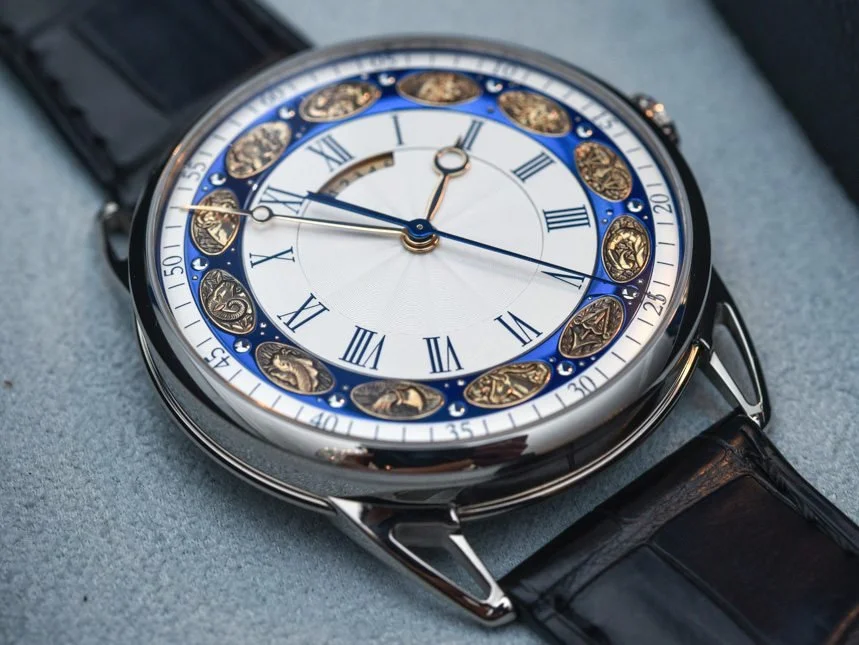Looking at De Bethune through Horological Alchemy by Denis Flageollet
4 Minute Read
The recent release of coffee table books from MB&F and De Bethune are great for enthusiasts of independent watchmaking. Where Instagram provides us all with easy-access exposure to independents and their creations, books simply are a great way to dive deeper into each brand’s creative process and stories behind the scenes. We loved MB&F’s catalogue raisonné so much that we pulled together some thoughts on the book and are keen to write something similar for another recent publication – Denis Flageollet’s Horological Alchemy. The master watchmaker driving De Bethune’s creativity and innovation over the last 20+ years published his thoughts on watchmaking, very broadly, in an interesting and unusual book.
Where De Bethune blurs the lines between traditional and modern, Horological Alchemy blurs the lines between a history of watchmaking, a philosophical exploration of the discipline, and a memoir. Tying together so many different thoughts in a cohesive manner is a genuine feat in writing. Without too many spoilers (we encourage you to read the book cover to cover), we’re going to walk through some of the more fascinating aspects of Flageollet’s musings on watchmaking.
Learning the fundamentals with the hand
One of the more fascinating aspects of Flageollet’s writings comes in the second chapter, “The Material,” where he discusses the value of learning the fundamentals of manufacturing, learning through the hand. It goes without saying that Flageollet has an insatiable curiosity. Any person who learns how to run their own forge, putting primary metals in the fire to create custom alloys, that person is simply on another level of self-learning. For Flageollet, it’s not a frivolous pursuit though. It’s not for marketing purposes. The value of returning to the fundamentals of manufacturing with primary metals and fire is that it creates something much less industrially sterile. As he puts it, “metal alloys used today have amazing mechanical properties, but they are purified, standardized and doped to such an extent, they no longer present the kinds of subtleties found in raw steels or alloys made in a charcoal fire.”
Returning to the fundamentals of metalwork opens the possibility to create timepieces that rise above the rest throughout the history of watchmaking. Specifically, the Dream Watch Series and the Maestri’Art Series come to mind here. We’re sure that Flageollet would not be able to pull the textures and colors out of materials if those metals were delivered by a supplier. Especially the Dream Watch Empreinte, that timepiece is a testament to the value of prototyping with primary metals and creating custom solutions for a specific purpose.
Art principles in watchmaking
The fourth chapter titled, “The Shapes,” dives into Flageollet’s thoughts on aesthetics – what goes into making beautiful timepieces. It’s rare to read such a detailed breakdown of watch aesthetics, especially from a master craftsman. As he mentions, “deep down, I have always felt that simplicity engenders aestheticism, and that aestheticism engenders reliability. Mechanisms that are too complex, that exist only for their own sake and not for the watch they are supposed to bring to life, are often poorly thought-out.” For Flageollet, there is no beauty without reliability, and that’s not simply a matter of mechanics and function.
The relationship between beauty and reliability is also tied to precision and power, its durability with the materials used, its wearability and ease of use. For an astute observer, these principles flow throughout De Bethune’s catalog. He mentions this principled approach to creating beautiful timepieces with the example of the DB25T Zodiac – a complicated, tourbillon movement with a simple, streamlined aesthetic. It’s also evident in the brand’s iconic “floating lugs,” where the lug profile is gorgeous without sacrificing wearability. It comes up every single time we handle a De Bethune timepiece with floating lugs, there’s simply nothing more comfortable on the wrist.
Long-form is the right medium for critique
Sometimes, you can hear well-reasoned critique about watchmaking in conversation at a watch industry or community event. It’s pretty rare to find it in the comment section of an Instagram post. Even more rare is critique written and published in a more long-form manner, especially when it comes from industry insiders. In Horological Alchemy, Flageollet is candid about his perceptions of some common industry pitfalls from the marketing-driven mindset in product development to the challenges of maintaining true, haute horlogerie standards when manufacturing large volumes to meet global demand.
Flageollet does it in a way where criticisms come across neither bitter nor personal. The critique is well reasoned, rooted in observation and experience with over 30+ years in the industry. Readers can tell that it comes from a place of love, from a place that desires to preserve handicraft knowledge. Generally, we’d love to see more long-form writing from the leaders of watchmaking brands, big and small. Whether it’s in the form of articles or books, candid feedback on the industry’s current affairs provides collectors and enthusiasts with much more to hold onto than what is usually found online. Outside of critique, we’re happy to see that De Bethune also released a book focused on the brand, its history, and commitment to craftsmanship with Assouline. More on the horizon, Rebecca Stuthers, the independent watchmaker in England, is releasing a book on the history of horology in June, 2023.
For those interested in diving into Denis Flageollet’s world, De Bethune has released a multi-part video series on the master watchmaker’s pursuit of the ultimate timepiece. An ultimate timepiece in the sense that it ties together all of Flageollet’s interests and knowledge in a cohesive manner. You can see the first two episodes of this project here – De Bethune’s Mecavers Project. If you’re keen to read Horological Alchemy, you can pick up an English-language copy from the Éditions Favre here.



